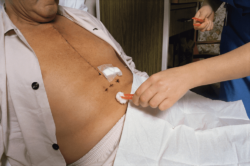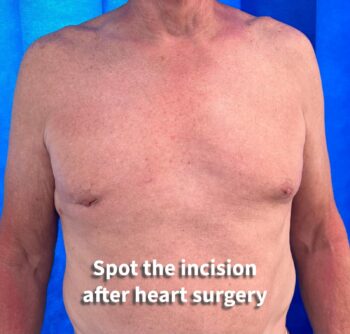Open Heart Surgery vs. Keyhole Heart Surgery: A Comprehensive Guide for Patients

Heart surgery is a critical procedure that can significantly improve the quality of life for those suffering from various cardiac conditions. As medical technology advances, patients now have more options when it comes to surgical approaches. This article will compare two main types of heart surgery: traditional open heart surgery and the newer keyhole heart surgery technique.
There is no doubt that if you are suitable for keyhole heart surgery, and you choose to have the procedure conducted by highly specialised surgeons, you are likely to obtain an excellent outcome and recover more quickly than with traditional open heart surgery performed through the full sternotomy cut.
Having said this, there are important pros and cons that you must be aware of when deciding on which treatment you prefer. This article will address these issues in depth to allow you to be better informed.
Open Heart Surgery: The Traditional Approach

Traditional Open Heart Surgery through the sternotomy
Open heart surgery, also known as traditional heart surgery, involves making a large incision down the middle of the chest and dividing the breastbone (sternotomy) to gain direct access to the heart[1]. This method has been the cornerstone of cardiac surgery for decades, allowing surgeons to have a clear view and direct control over the heart during complex procedures.
Procedure Overview During Open Heart Surgery:
1. Surgeons make a 6- to 8-inch-long incision down the center of the chest[2].
2. The breastbone is cut and spread apart to expose the heart[2].
3. The patient is connected to a heart-lung machine, which takes over the heart’s pumping function during the surgery[1].
4. The necessary cardiac procedure is performed, such as coronary artery bypass grafting (CABG), valve repair or replacement, or congenital heart defect correction[1].
5. Once the repair is completed, the heart is restarted, and the patient is disconnected from the heart-lung machine[2].
6. The breastbone is closed using wire or sutures, and the chest incision is sutured[2].
Keyhole Heart Surgery: A Minimally Invasive Alternative

Keyhole Mitral Valve Surgery
Keyhole heart surgery, also known as minimally invasive heart surgery, is a more recent innovation in cardiac surgery. This technique uses small incisions between the ribs or on the side of the chest, avoiding the need for a sternotomy[1][3].
Procedure Overview During Keyhole Heart Surgery:
1. Surgeons make several small incisions, typically between the ribs[8].
2. Specialized instruments and cameras are inserted through these incisions to perform the surgery[3].
3. The heart may still be connected to a heart-lung machine, but some procedures can be performed on a beating heart[3].
4. The necessary cardiac procedure is carried out using specialised tools and camera guidance.
5. Once complete, the small incisions are closed.
Comparing Recovery and Outcomes
Speed of Recovery
One of the most significant advantages of keyhole heart surgery is the faster recovery time:
- Open heart surgery typically requires a hospital stay of a week or more, followed by several weeks of recovery at home[3]. The sternum takes about 12 weeks to fully heal[1].
- Keyhole surgery patients often have a shorter hospital stay, usually just a few days[3]. Most patients can resume normal activities within 4 weeks[4].

Recovery at 4 weeks following keyhole heart surgery.
Cosmetic Results
Keyhole surgery offers superior cosmetic outcomes:
- Open heart surgery leaves a long, visible scar down the centre of the chest[5].
- Keyhole surgery results in smaller, less noticeable scars[3][6].
Risk of Infection
Keyhole surgery may reduce the risk of infection:
- Open heart surgery, with its large incision and divided breastbone, carries a higher risk of sternal wound infection[8].
- The smaller incisions in keyhole surgery lower the risk of infection, particularly serious bone infections[4][8].
Bleeding and Pain
Keyhole surgery generally results in less bleeding and pain:
- Open heart surgery often requires blood transfusions due to significant blood loss [6].
- Keyhole surgery patients typically experience less postoperative pain and discomfort [3][8].
- The reduced surgical trauma in keyhole procedures often leads to less bleeding and a lower need for blood transfusions [8].
Potential Drawbacks of Keyhole Heart Surgery
While keyhole heart surgery offers many benefits, it’s important to consider its limitations:
1. Requires Highly Experienced Surgeons: Keyhole procedures are technically demanding and require specialized training and experience.
2. Not Suitable for All Patients: Factors such as the patient’s overall health, the extent and location of coronary artery disease, and specific cardiac conditions may make some patients unsuitable for keyhole surgery[3][6].
3. Risk of Conversion: There is a 1-5% risk (depending on the specific procedure) that a keyhole surgery may need to be converted to an open heart surgery during the operation if complications arise or better access is required.
4. Limited Visibility: While specialised cameras provide good visualization, the indirect view of the heart can be challenging in complex cases.
5. Not Appropriate for All Procedures: Some complex cardiac surgeries may still require the open heart approach for optimal results.
6. Keyhole heart surgery is more costly than open heart surgery for patients who wish to self-fund their procedure.
Making an Informed Decision
Choosing between open heart surgery and keyhole heart surgery is a significant decision that should be made in consultation with experienced cardiac surgeons. The team at the Keyhole Heart Clinic has performed thousands of both open and keyhole procedures over 21 years and is well-placed to advise on your suitability for either approach.
Factors to consider when making your decision include:
- Your specific heart condition and its severity
- Your overall health and medical history
- The expertise and recommendations of your surgical team
- Your personal preferences regarding recovery time and scarring
Conclusion
Both open heart surgery and keyhole heart surgery have their place in modern cardiac care. While open heart surgery remains the gold standard for certain complex procedures, keyhole surgery offers significant benefits in terms of recovery time, pain management, and cosmetic outcomes for suitable candidates.
If you are suitable keyhole heart surgery, and you choose to have the procedure conducted by highly specialised surgeons, you are likely to obtain an excellent outcome and recover more quickly than with traditional open heart surgery performed through the full sternotomy cut.
As with any major medical decision, it’s crucial to have thorough discussions with your healthcare providers to understand the nuances of each approach and determine the most appropriate treatment plan for your specific cardiac health needs.
Citations:
[1] https://dradityalad.com/difference-between-open-heart-surgery-keyhole-bypass/
[2] https://www.medparkhospital.com/en-US/disease-and-treatment/open-heart-surgery
[3] https://www.thekeyholeheartclinic.com/blog/the-benefits-of-keyhole-heart-surgery-over-open-heart-surgery/
[4] https://www.thekeyholeheartclinic.com/services/keyhole-therapies/
[5] https://my.clevelandclinic.org/health/procedures/21502-open-heart-surgery
[6] https://www.topdoctors.co.uk/medical-articles/understanding-your-heart-standard-vs-keyhole-bypass-surgeries
[7] https://my.clevelandclinic.org/health/treatments/24016-sternotomy
[8] https://www.thekeyholeheartclinic.com/blog/what-is-keyhole-heart-surgery/
[9] https://www.utmbhealth.com/services/cardiovascular-thoracic-surgery/procedures-conditions/chest-wall-repair/Rib-Sternum-Repair

